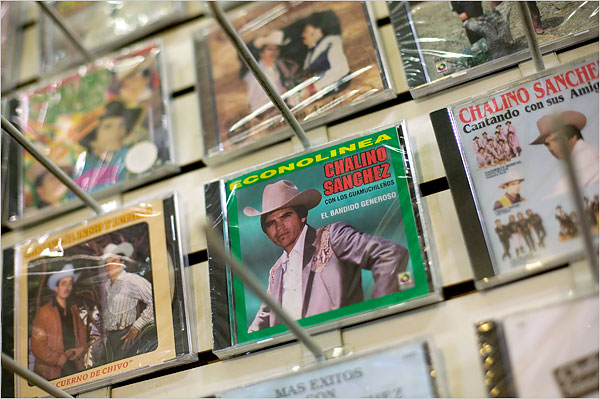
Photo: Eric Grigorian for The New York Times
This past weekend, the N.Y. Times‘ Travel section revisited Los Angeles, focusing on narcocorridos and venues that play an important part in its spread throughout Los Angeles. It went better this time than the last time they visited L.A.
Narcocorridos, and by extension, any form of Mexican music that is born and nourished in Los Angeles, are not covered much in the United States. Almost every time narcocorridos are mentioned in media, it’s tied with the current Mexican Drug war fiasco and spoken about negatively. I once sat in on a discussion with a well-known Mexican journalist at a university and she all but blamed the whole situation in Mexico & the Americas on narcocorridos. The whole time I sat there, I shook my head, unable to comprehend how someone could explicitly blame corridos for the “drug war” in México.
Coverage of narcocorridos in the U.S. is much different than in México. The United States is much less subjective than México in its coverage of narcocorridos. Mexican journalists have bought the Mexican government’s argument that narcocorridos are to blame for the drug trade and must be banned from radio play. American journalists have gone further into narcocorridos, documenting its rise and popularity among Mexicans in the United States and the constant airplay in radio. It’s a musical form that allows the children of Mexican immigrants to become immensely popular, though the singing is sometimes sub-par.
The N.Y. Times did a good job with this article, going around to small bars locations around mostly South-Central & Southeast L.A., the origins of most forms of Mexican music & artists that have emerged from L.A. (Voces del Rancho, Chalino Sanchez, Adan “Chalino” Sanchez, Saúl Viera “El gavilancillo,” Pedro, Lupillo, & Jenni Rivera, etc.). Of course, no article about contemporary Mexican music in Los Angeles can ignore Chalino Sánchez and this article is not the exception.
I don’t know what more to say about the article. I think it’s a good primer on Mexican music in Los Angeles, as good as can be expected from any Travel section. While most Travel sections stay the hell away from any area between Downtown L.A. and the beaches of southern Los Angeles county, this article treated them better than I’ve heard some people in L.A. talk about these areas.
¿Qué piensan?
DISCLOSURE: The owners of El Farallon & El Dorado Night Club are relatives of mine. Additionally, many workers at these establishments, past and present, are relatives or family friends.
Image at the top of the post is taken from the article’s accompanying slideshow. Crossposted at my site.

I’m a fan of much of this “narco” music, mostly because they usually tell interesting stories about the method by which they make their living. I just heard a new one (to me) today by Los Tigres which basically suggested all drug dealers should form an alliance to defeat La Perra that is the DEA. Besides being a decent song, the letra was way more intriguing than anything you hear in English.
Do you think they wrote this story for journalistic cred or do you think they’re trying to encourage New Yorkers to fly to LA and cruise around Southgate and South Central? The article also doesn’t seem to have an end.
Vidalia, great point. So much for the NY Times’ “travel” section. Looks like their travel dept. is nothing more than a temporary stop for laid off writers from other departments, including the world news crime blotter, as this would indicate.
Not knowledgeable about Narco corridos aside from hearing it once in a while and having family members who expose me to it at family parties, yet I have many times stopped to listen and see a militancy and Mexican Pride that is strengthened when hundreds or thousands of miles away from home; sometimes the lyrics and tone are closely related to identity, to the “us” vs “them” feelings of the oppressed — very similar to the “Thug Life” and “all white people are ‘blue-eyed devils’ mentality”. Whether this is simplistic, accurate, healthy, or damaging is a far more complex issue.
Overall, a huge amount of expressive art is a release of unfiltered emotion, thoughts and ideas, not diplomatic or PC discourse, so que vivan los narco corridos, que Viva Mexico, Cabrones!
Once again another reason why the New York Times is a better newspaper than the El Lay Times.
Instead the LA Times been hawking their “new” website…hazme el pinche favor..lol
And i call it first…I want a 3 some with Pedro and Lupillo.
– im on team Jenny Rivera…not Graciela Beltran
Y soledadenmasa dame 3 de Negra Modelo por favor 🙂
Chavo,
What song is it? I’d like to hear it. I thought Los Tigres del Norte had stopped writing new narcocorridos, but I guess I’m wrong.
Javier,
I’ve thought about the same thing! I think it’s just something that can’t be sold, but found out through friends, like the journalist.
Great article it even mentioned the Chalino shootout in Coachella, although it fails to mention that he shot and killed the wrong man.
I accidentally put the anti-spam word in the name box (eatbeans)… sorry guys. They also quoted a song that actually gets a lot of play in Nayarit at a local “jaripeos” and “bailes”
http://www.youtube.com/watch?v=ts6xNnrN17c
Good clip eat beans errrr urbanista. Los malos muchachos siempre hacen las Mamas grito.